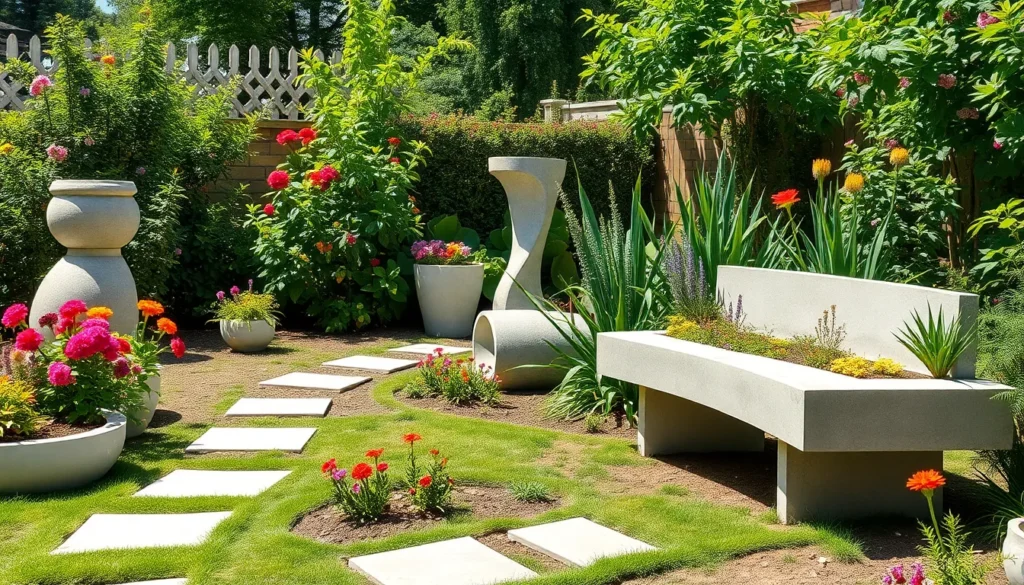Transform your outdoor space into a stunning sanctuary with creative cement projects that’ll make your neighbors green with envy. We’ve discovered that concrete isn’t just for driveways and foundations – it’s actually one of the most versatile and affordable materials for crafting unique garden features that last for decades.
From elegant planters and stepping stones to eye-catching sculptures and functional garden borders concrete opens up endless possibilities for DIY enthusiasts and seasoned gardeners alike. The best part? Most cement garden projects require minimal tools and can be completed over a weekend without very costly.
Whether you’re looking to add modern geometric planters to your patio or create rustic garden pathways that blend seamlessly with nature we’ll show you how to harness cement’s incredible potential. These projects aren’t just budget-friendly – they’re also incredibly durable and can withstand harsh weather conditions while maintaining their beauty year after year.
Creative Cement Planters for Your Garden Space
Transform ordinary concrete into stunning planters that’ll become the focal points of your outdoor sanctuary. We’ve discovered that cement planters offer unmatched durability while providing endless creative possibilities for every garden style.
DIY Concrete Pots Using Household Items
Repurpose everyday household items to create unique concrete planters without spending a fortune on specialized molds. Old towels soaked in concrete mixture can be draped over buckets or bowls to form organic, flowing planter shapes that add artistic flair to your garden beds. We recommend using plastic containers like yogurt cups, food storage bins, or even cardboard boxes as inner and outer molds for traditional round or square planters.
Create textured surfaces by pressing leaves, lace doilies, or bubble wrap into the wet concrete before it sets completely. Kitchen colanders work exceptionally well as molds for drainage-friendly planters since they naturally create perfect holes in the bottom. We’ve found that using two different sized containers creates the perfect wall thickness for small to medium planters.
Mix your concrete with a 3:1 ratio of sand to Portland cement, adding water gradually until you achieve a thick, moldable consistency. Remove the molds after 24 hours of curing, then allow an additional week for the concrete to reach full strength before planting.
Decorative Cement Planters With Textured Finishes
Apply various texturing techniques to transform plain concrete planters into eye-catching garden accessories. We create stunning stone-like finishes by pressing actual stones, shells, or decorative glass pieces into the surface while the concrete remains workable. Rope wrapped around the exterior creates beautiful spiral patterns that complement rustic garden themes.
Stamp patterns using rubber stamps, carved wooden blocks, or even household items like forks and combs to achieve professional-looking designs. We recommend experimenting with different concrete stains or acrylic paints to add color variations that match your existing garden palette. Brushed finishes created by dragging a stiff brush across partially set concrete produce elegant lined textures.
Create mosaic effects by embedding broken tiles, pottery shards, or colorful stones directly into the wet concrete surface. Sand the finished planters lightly after full curing to smooth any rough edges while preserving the desired texture patterns.
Large-Scale Cement Containers for Statement Plants
Design oversized concrete planters that can accommodate trees, large shrubs, or dramatic plant arrangements in your garden space. We construct these substantial containers using wooden forms or large cardboard boxes as molds, ensuring walls are at least 2 inches thick for structural integrity. Reinforcement with wire mesh or rebar becomes essential for planters exceeding 24 inches in any dimension.
Calculate the concrete mixture carefully since large planters require important amounts of materials and proper drainage systems. We install PVC pipes or create gravel layers at the bottom to prevent water accumulation that could damage plant roots. Consider adding wheels or casters to the base before the concrete sets if you’ll need to move these heavy planters seasonally.
Plan the placement carefully since these statement planters can weigh several hundred pounds when filled with soil and plants. We often create matching sets of 2-3 large planters in graduated sizes to establish visual hierarchy and create stunning focal points throughout garden pathways or patio areas.
Cement Pathway Ideas to Transform Your Garden
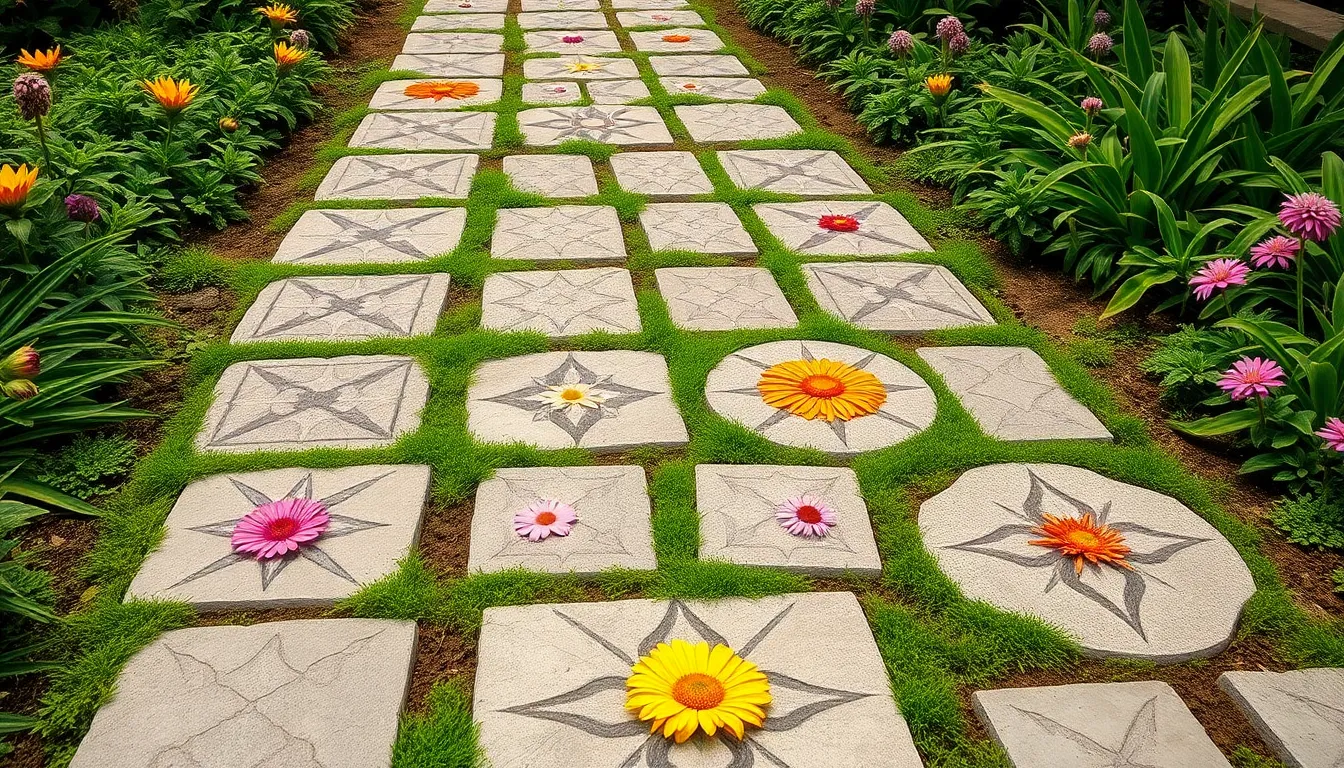
Moving beyond planters, we can create stunning walkways that guide visitors through our outdoor spaces while adding functional beauty to the industry.
Stepping Stone Pathways With Custom Designs
Custom stepping stones offer endless creative possibilities for personalizing our garden paths. We can use tools like the QUIKRETE Walk Maker to create unique backyard designs that reflect our individual style and preferences. Patterns ranging from geometric shapes to floral motifs transform ordinary concrete into artistic expressions.
Personalized messages embedded in stepping stones add meaningful touches to our pathways. Names, dates, or inspirational quotes become permanent features that tell our garden’s story. These customized elements create conversation pieces while maintaining the practical function of the walkway.
Natural integration enhances the organic feel of cement stepping stone pathways. We can plant grass or small flowering plants between stones to create a harmonious blend with the surrounding network. This combination softens the industrial appearance of concrete while maintaining its durability and weather resistance.
Continuous Cement Walkways With Decorative Borders
Decorative borders elevate the visual appeal of standard cement walkways significantly. We can incorporate patterns like cobblestone textures or clean geometric edges to achieve either rustic charm or modern sophistication. These design elements transform basic concrete paths into striking industry features.
Material versatility allows us to experiment with various border treatments and textures. Small stones, recycled bricks, or colored aggregates can be pressed into wet cement to create distinctive edges. These additions provide visual interest while defining the pathway boundaries clearly.
Border patterns can complement our existing garden design themes seamlessly. Whether we prefer contemporary minimalism or cottage garden aesthetics, decorative cement borders can be customized to match our overall industry vision.
Mixed Material Paths Combining Cement and Natural Elements
Cobblestone and flat stone combinations create naturally textured pathways with lasting durability. We can embed these materials directly into cement bases to achieve authentic rustic appearances while maintaining structural integrity. This approach combines the best qualities of natural stone with concrete’s affordability and longevity.
Broken concrete pieces and recycled bricks arranged in organic patterns offer sustainable pathway answers. These materials can be positioned in free flowing designs that mimic natural stone formations while reducing construction waste. The irregular shapes create visual interest and complement informal garden styles perfectly.
Strategic material placement ensures both aesthetic appeal and practical functionality in mixed pathways. We can alternate cement sections with natural elements to create rhythm and visual flow while maintaining comfortable walking surfaces throughout the entire path length.
Functional Cement Garden Furniture Projects
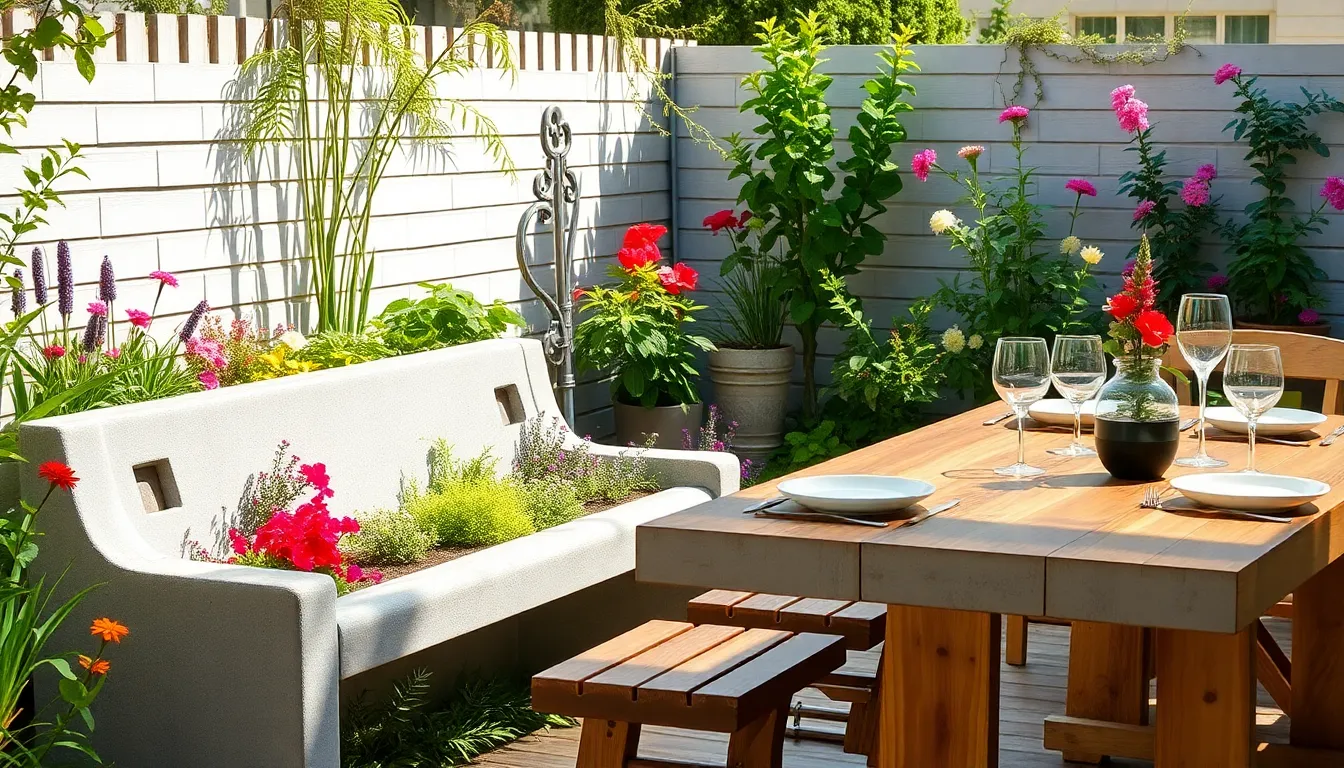
Building on our decorative cement elements, we’ll now explore sturdy furniture pieces that combine practicality with enduring style for your outdoor living spaces.
Cement Garden Benches for Relaxation Areas
Plant Perch Lounge benches offer the perfect blend of seating and gardening functionality. We love how these multifunctional pieces feature built-in planters that create natural armrests while providing weather-resistant finishes. The ergonomic design ensures comfortable seating for extended relaxation periods.
Stripped Elegance Bench designs showcase linear patterns that add visual interest to any garden setting. These benches resist UV damage and staining, making them ideal for sunny locations where traditional materials might fade or deteriorate. The clean lines complement both modern and traditional industry designs.
Saga Bench construction demonstrates seamless building techniques with subtle texturing that enhances grip and visual appeal. We particularly appreciate the integrated drainage channels that prevent water pooling and extend the bench’s lifespan. This design works exceptionally well in areas prone to heavy rainfall.
Outdoor Cement Tables for Dining and Entertainment
Durable cement table construction withstands extreme weather conditions that would damage wood or metal alternatives. We recommend reinforcing the structure with rebar for tables spanning more than 4 feet to ensure stability during gatherings. The solid construction eliminates wobbling that often plagues traditional outdoor furniture.
Versatile design integration allows cement tables to incorporate complementary materials like reclaimed wood tops or metal accents. We’ve seen stunning combinations where cement bases support live-edge wooden surfaces, creating conversation pieces that bridge industrial and natural aesthetics. These mixed-material approaches expand design possibilities while maintaining structural integrity.
Customizable surface treatments enable unique texturing and coloring options that match existing garden themes. Stamped patterns, exposed aggregate finishes, and acid staining techniques transform plain concrete into sophisticated dining surfaces that rival expensive stone alternatives.
Cement Fire Pit Surrounds for Cozy Gatherings
Heat-resistant cement surrounds provide safe barriers around fire features while improving the overall ambiance of gathering spaces. We recommend using high-temperature concrete mixes that won’t crack under thermal stress. The thermal mass properties help retain and radiate heat long after flames die down.
Customizable surround patterns allow for creative expression through various finishing techniques and integrated materials. Decorative stones, tile inlays, or stamped designs transform basic surrounds into stunning focal points. We’ve observed that curved designs promote better conversation flow compared to angular alternatives.
Weather durability features ensure fire pit surrounds maintain their appearance through seasonal changes and temperature fluctuations. Proper sealing prevents moisture infiltration that could cause cracking during freeze-thaw cycles. The low-maintenance nature makes these surrounds practical choices for year-round outdoor entertainment areas.
Decorative Cement Garden Sculptures and Art
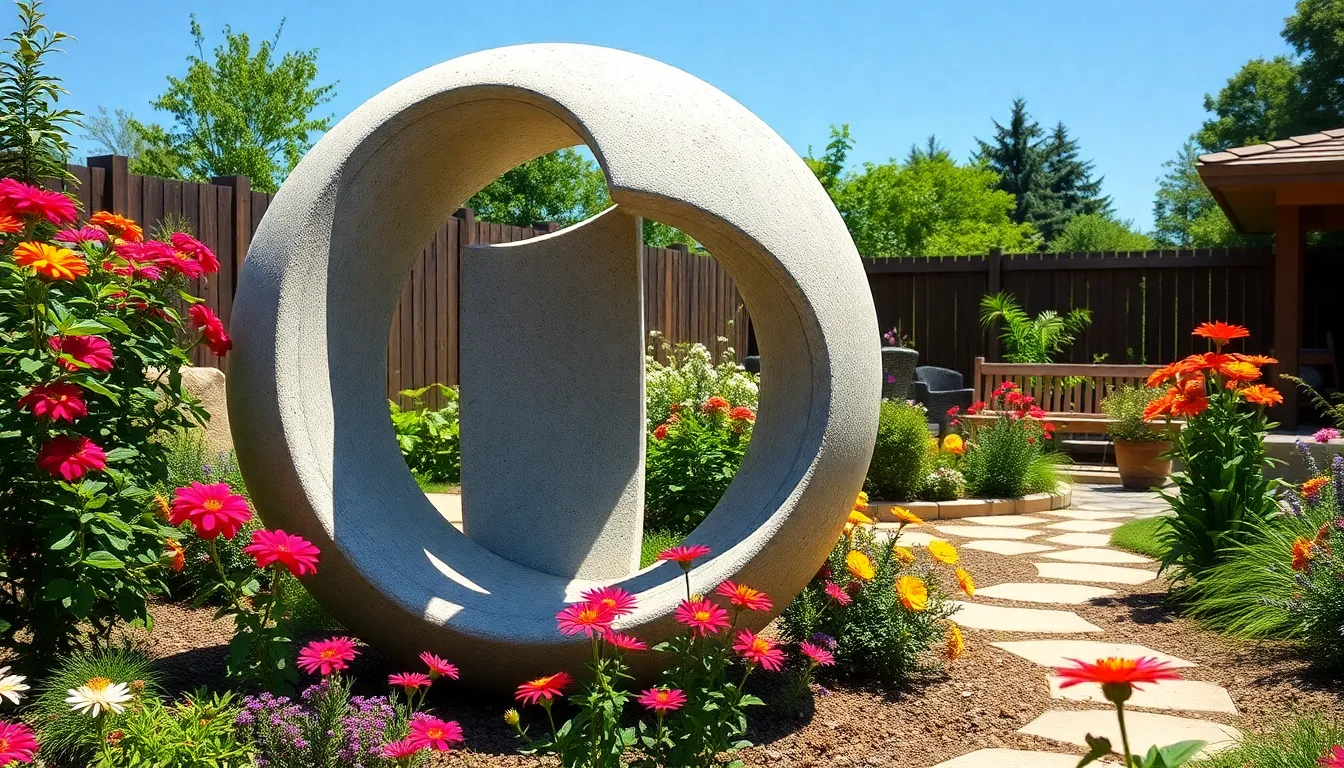
Building on the functional cement elements we’ve explored, artistic cement sculptures transform ordinary gardens into captivating outdoor galleries. These permanent art pieces create stunning visual anchors that complement your existing planters and pathways while requiring minimal maintenance.
Abstract Cement Sculptures as Focal Points
Geometric sculptures offer contemporary elegance that contrasts beautifully with organic garden elements. We recommend creating spheres, cubes, or cone shapes in various sizes to establish visual hierarchy throughout your outdoor space. Large geometric pieces work exceptionally well as centerpieces for circular garden beds or at pathway intersections.
Abstract forms with unique textures serve as conversation starters while adding artistic sophistication to your industry. These sculptures can incorporate rough surfaces, smooth curves, or carved patterns that play with light and shadow throughout the day. Consider positioning these pieces where they’ll catch morning or evening light for maximum dramatic effect.
Modern installations using cement allow for creative expression through unconventional shapes and contemporary design elements. We’ve seen successful projects featuring twisted columns, interlocking forms, and asymmetrical designs that create ever-changing visual interest without overwhelming smaller garden spaces.
Cement Garden Statues and Figurines
Functional statues that double as planters maximize both beauty and utility in compact gardens. These hybrid pieces can house trailing plants or seasonal flowers while serving as sculptural elements. Angel figures with hollow wings or mythological creatures with basin like features create charming focal points that evolve with your plantings.
Animal figurines including birds, rabbits, and insects bring whimsical charm to gardens while creating naturalistic scenes. We particularly love cement butterfly sculptures perched among flowering plants or rabbit families positioned near vegetable gardens. These pieces work especially well in children’s garden areas or cottage style landscapes.
Ornamental figurines featuring angels, nymphs, or mythological creatures add classical elegance to formal garden designs. Position these traditional sculptures near water features, at garden entrances, or as endpoints for garden paths to create sophisticated outdoor rooms that feel both timeless and inviting.
Textured Cement Wall Art for Vertical Spaces
Vertical panels with molded textures transform blank garden walls into striking backdrops for climbing plants or standalone art installations. We recommend creating panels with wave patterns, geometric reliefs, or nature inspired textures that complement your garden’s theme. These panels can be painted or left natural depending on your design preferences.
Mosaic art using cement bases allows for incredible creativity through the incorporation of tiles, glass pieces, or natural stones. Create large scale images, abstract patterns, or themed designs that reflect your garden’s personality. Weather resistant grout ensures these artistic elements maintain their beauty through all seasons.
Textured wall installations can incorporate embedded elements like shells, stones, or metal accents for added visual depth. Consider creating relief sculptures that tell stories or represent themes meaningful to your family, turning garden walls into personalized art galleries that guests will remember long after their visit.
Cement Water Features for Garden Ambiance

Water features transform gardens into tranquil retreats where we can escape everyday stress and enjoy nature’s soothing sounds. These cement additions create focal points that enhance our outdoor spaces while providing durability that withstands weather challenges for years.
DIY Cement Fountains and Water Bowls
Creating our own cement fountains offers incredible satisfaction while saving important costs compared to purchasing ready-made options. We can mix concrete with fiberglass to add strength and durability, ensuring our water features last through multiple seasons without cracking or deteriorating.
Molding techniques allow us to shape unique designs that reflect our personal style and garden theme. Large mixing bowls, decorative planters, or custom-built forms become the foundation for stunning water bowls that birds and beneficial insects will appreciate. We’ll need basic materials like concrete mix, waterproof sealant, and a small pump system to bring our vision to life.
Budget-conscious gardeners benefit from DIY approaches since we control every aspect of design and cost. Professional water features often cost hundreds or thousands of dollars, while our homemade versions require minimal investment in materials and tools.
Cement Pond Edges and Water Garden Borders
Pond edges define water features while preventing erosion and maintaining proper water levels throughout seasonal changes. We can create stable borders using poured concrete that follows natural curves or geometric patterns depending on our industry design preferences.
Various shapes and textures become possible when we design custom pond borders using different finishing techniques. Stamped patterns, embedded stones, or smooth surfaces complement existing garden elements while providing functional benefits like seating areas around larger water features.
Reinforcement becomes essential for larger pond installations where we expect heavy use or potential ground movement. Steel mesh or rebar additions ensure our cement borders remain intact during freeze-thaw cycles and provide long-lasting structural integrity.
Water level maintenance improves significantly when we install properly designed cement borders that create clear boundaries between planted areas and water zones. These borders also help cleaning and maintenance tasks while improving the overall appearance of our water gardens.
Modern Cement Water Walls and Cascades
Contemporary water walls create dramatic focal points that transform ordinary garden spaces into sophisticated outdoor environments. We can construct these features using modular cement panels that allow water to flow smoothly down textured or smooth surfaces, creating mesmerizing visual effects.
Cascading designs offer multiple levels where water flows from one tier to another, producing varied sounds and visual interest throughout the day. Cast stone materials provide durability while offering various textures and colors that blend seamlessly with our existing garden elements.
Installation techniques for modern water walls require proper foundation preparation and waterproofing to ensure long-term performance. We’ll need to consider pump placement, electrical connections, and drainage systems that maintain water circulation while preventing overflow during heavy rain periods.
Lighting integration enhances these water features during evening hours when strategic placement of LED fixtures creates stunning reflections and shadows. Underwater lighting or spotlights positioned behind flowing water produce dramatic effects that extend our garden’s usability into nighttime hours.
Practical Cement Garden Structures

Moving beyond decorative elements, we’ll explore essential cement structures that provide both functionality and lasting value to your garden space.
Cement Raised Garden Beds for Vegetables
Cement raised garden beds offer superior durability compared to traditional wood alternatives, lasting decades without replacement. We recommend constructing beds 8-12 inches high for shallow root vegetables like lettuce and radishes, while deeper beds of 18-24 inches work best for tomatoes and root vegetables. These concrete structures retain soil moisture more effectively than wood beds and create an impermeable barrier against underground pests like gophers and moles.
Building cement raised beds requires minimal tools and can be completed over a weekend using pre-mixed concrete and simple wooden forms. The concrete maintains consistent soil temperature and prevents nutrient leaching that commonly occurs with wooden beds. We’ve found that adding drainage holes every 2-3 feet along the bottom prevents waterlogging and promotes healthy root development.
Cement Garden Edging and Border Answers
Cement edging creates crisp, professional lines that define planting areas and prevent grass encroachment into flower beds. Poured concrete borders can be molded into curves and custom shapes that complement your garden’s natural flow, unlike rigid manufactured alternatives. We recommend installing edging 4-6 inches deep to effectively block grass roots while maintaining a 2-3 inch visible height for aesthetic appeal.
Decorative stamping and coloring techniques transform basic cement borders into attractive design elements that coordinate with existing hardscaping. Exposed aggregate finishes provide texture and visual interest while maintaining durability against weather and lawn equipment damage. These permanent borders eliminate the need for annual replacement of plastic or metal edging materials.
Cement Steps and Retaining Walls
Cement steps provide safe, slip resistant access between different garden levels while withstanding freeze thaw cycles that damage other materials. We design steps with a 7-inch rise and 11-inch tread depth for comfortable navigation, incorporating textured surfaces for enhanced grip during wet conditions. Proper concrete steps can support heavy loads and require minimal maintenance compared to wood or stone alternatives.
Retaining walls made from cement blocks or poured concrete effectively manage slope erosion while creating terraced planting opportunities. These structures can incorporate built in planters and drainage systems that prevent water buildup behind the wall. We recommend reinforcing walls over 3 feet high with steel rebar and proper footings to ensure long term stability and prevent costly failures.
Cement Garden Lighting Solutions
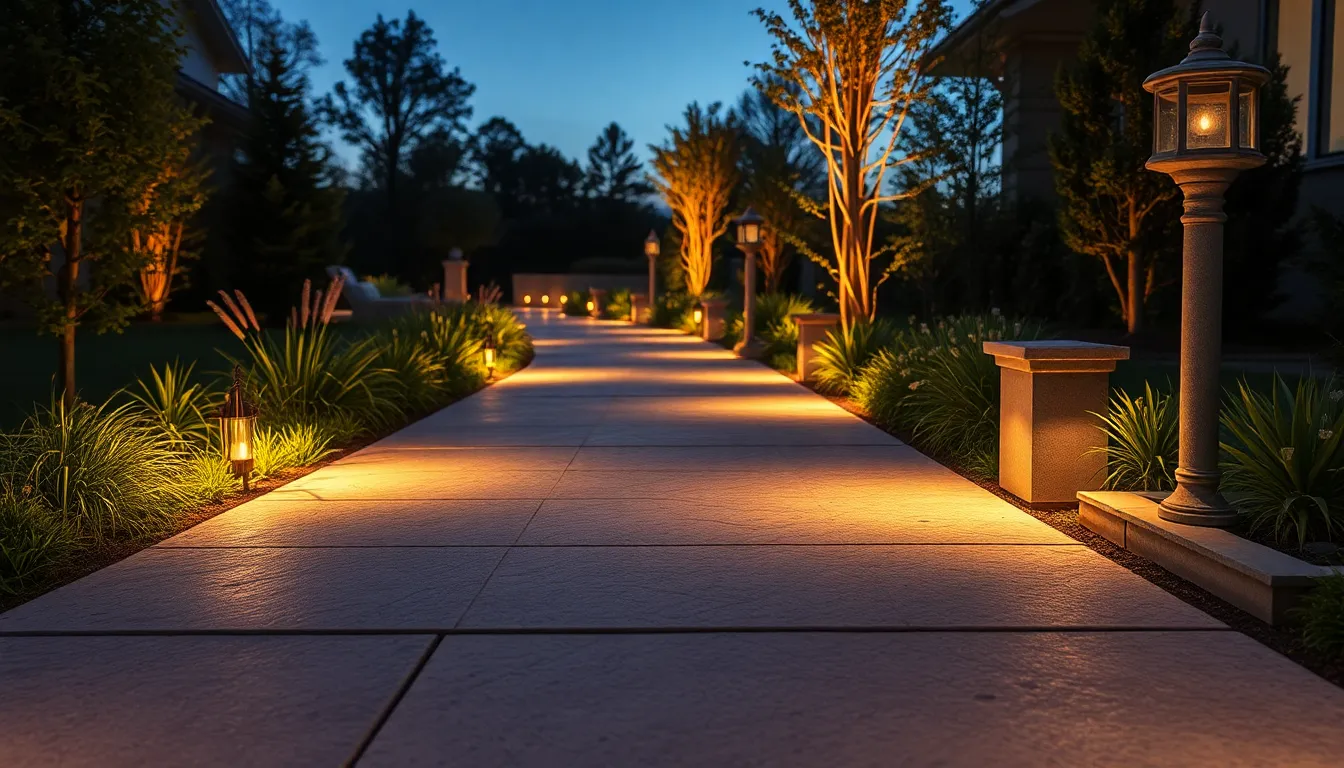
Strategic lighting transforms cement features into stunning evening showcases that extend your garden’s usability well into the night.
Embedded LED Lights in Cement Pathways
Embedded LED lights in cement pathways create illuminated walkways that enhance both safety and visual appeal during evening hours. We recommend installing low-voltage LED strips directly into the concrete during the pouring process to ensure seamless integration. These lights can be positioned along pathway edges or embedded in the center of stepping stones to create dramatic lighting effects.
Installation requires planning your electrical layout before pouring the cement. Position waterproof LED strips approximately 6 inches apart for optimal light distribution. Solar-powered options eliminate the need for complex wiring while reducing energy costs. The embedded lighting approach provides durability since the fixtures remain protected within the concrete structure.
Weather-resistant LED options ensure your pathway lighting withstands harsh outdoor conditions. Choose warm white LEDs (3000K) for a welcoming atmosphere or cool white (5000K) for modern aesthetics. Timer controls allow automatic operation, turning lights on at dusk and off at dawn for convenience and energy efficiency.
Cement Lamp Posts and Garden Lighting Fixtures
Cement lamp posts offer sturdy and durable lighting answers that complement various garden styles through customizable molding techniques. We can create unique designs ranging from sleek modern columns to decorative traditional styles using simple concrete molds. These fixtures provide substantial weight that eliminates the need for extensive anchoring systems.
Garden lighting fixtures crafted from cement include pendant lamps, wall sconces, and decorative lanterns that add modern touches to outdoor spaces. Reinforcement with steel rebar ensures structural integrity for taller lamp posts. Surface texturing techniques like stamping or brushing create distinctive patterns that match existing garden themes.
Maintenance requirements remain minimal since cement fixtures resist weathering and UV damage. Built-in conduit channels during construction allow easy wiring installation. These permanent fixtures increase property value while providing reliable illumination for years of outdoor enjoyment.
Illuminated Cement Planters for Evening Appeal
Illuminated planters combine plant display with ambient lighting to create stunning focal points that highlight vegetation during evening hours. We recommend installing LED strip lights around the interior rim of planters or beneath raised sections to create dramatic uplighting effects. These designs showcase both the plants and the planter’s architectural features.
Construction involves creating recessed channels for light installation during the molding process. Waterproof LED strips work best for direct plant contact areas. Battery-powered options provide flexibility for portable planters while hardwired systems suit permanent installations. Drainage considerations ensure proper water management without compromising electrical components.
Various shapes and sizes accommodate different garden themes from contemporary geometric designs to organic curved forms. Integrated timers and dimmer controls allow customization of lighting intensity throughout the evening. These multifunctional features serve as both planters and industry lighting, maximizing your garden’s visual impact while conserving space.
Budget-Friendly Cement Garden Projects

Building beautiful garden features doesn’t require expensive materials or professional installation. We can create stunning cement projects using basic supplies and simple techniques that cost a fraction of store-bought alternatives.
Simple Cement Crafts Using Basic Materials
DIY Concrete Pavers offer unlimited customization using plastic containers as molds. We transform everyday storage containers into unique pathway elements, creating custom shapes and sizes that save money compared to manufactured pavers. Each project allows complete creative control over dimensions and patterns.
Garden Edging provides structure and visual appeal using basic cement mixing techniques. We define garden beds and create mowing strips that prevent grass encroachment while adding professional-looking boundaries. This approach costs significantly less than purchasing pre-made edging materials.
Concrete Planters use household items as molds for custom growing containers. We repurpose buckets, bowls, and containers to cast unique planters that match our garden’s aesthetic. Basic materials like cement mix and improvised molds create stunning results without specialty equipment.
Concrete Garden Globes combine cement with balloons for decorative spherical elements. We use standard party balloons as forms, creating hollow or solid orbs that add visual interest throughout garden spaces. This technique produces professional-looking results using materials from any grocery store.
Upcycled Cement Ideas From Waste Materials
Reusing Old Containers transforms household waste into valuable project molds. We convert plastic yogurt containers, cardboard tubes, and food packaging into forms for cement casting. Each discarded item becomes a potential mold, reducing waste while saving money on specialized equipment.
Hand-Painted Faux Rugs apply decorative paint to concrete surfaces for artistic appeal. We create weatherproof designs that mimic fabric patterns using standard acrylic paints on cured cement. This technique transforms plain concrete into eye-catching decorative elements.
Transforming Old Pallets combines salvaged wood with cement for unique outdoor furniture. We incorporate weathered pallet boards into concrete projects, creating rustic planters and seating with character. Discarded shipping materials gain new life as structural elements in cement projects.
Small-Scale Cement Projects for Beginners
Mini Planters provide perfect starting projects for newcomers to cement crafting. We cast small containers using basic mixing techniques and simple molds like plastic cups or food containers. These projects require minimal materials and offer quick satisfaction for beginning crafters.
Stepping Stones allow personalization through custom casting into accessible molds. We create unique pathway elements by pressing leaves, shells, or decorative objects into fresh cement. Each stone becomes a personalized garden feature that reflects individual style preferences.
Coasters and Decorative Stones serve dual purposes as functional items and garden accents. We cast small concrete pieces using shallow molds, creating weather-resistant coasters for outdoor entertaining. These projects use minimal cement while producing useful results that enhance garden functionality.
Conclusion
We’ve explored the incredible potential of cement to transform any garden space into a personalized outdoor oasis. From elegant planters and functional furniture to artistic sculptures and soothing water features these concrete projects offer durability that withstands years of weather while maintaining their beauty.
The versatility of cement allows us to create both decorative elements and essential structures that serve practical purposes in our gardens. Whether we’re working with a tight budget using household items or investing in larger statement pieces the possibilities are truly endless.
Most importantly these cement projects give us the freedom to express our creativity while building lasting value in our outdoor spaces. With basic tools and weekend effort we can create unique garden features that reflect our personal style and enhance our enjoyment of outdoor living for years to come.
Frequently Asked Questions
What materials do I need for DIY cement garden projects?
Basic cement projects require concrete mix, water, molds or forms, and simple tools like trowels and buckets. For textured finishes, you’ll need items like rubber stamps, stones, or household objects for impressions. Most projects can be completed with materials from your local hardware store and items you already have at home.
How long do cement garden features last outdoors?
Properly constructed cement garden features can last decades with minimal maintenance. Concrete is highly durable and weather-resistant, withstanding extreme temperatures, rain, and UV exposure. The key is using quality concrete mix and allowing proper curing time, typically 24-48 hours before handling and up to 28 days for full strength.
Can I make cement planters without expensive molds?
Yes, you can create unique cement planters using household items as molds. Old towels, plastic containers, cardboard boxes, and even balloons work well. These improvised molds often create more interesting textures and shapes than store-bought alternatives, making your planters truly one-of-a-kind while keeping costs minimal.
How do I add texture to cement garden projects?
Create texture by pressing objects into wet concrete, such as leaves, stones, or rubber stamps. You can also use towels, bubble wrap, or mesh for interesting patterns. For smooth finishes, float the surface with a trowel. Experiment with different household items to achieve unique textures that complement your garden’s style.
Are cement garden projects suitable for beginners?
Absolutely! Many cement projects require no special skills and can be completed over a weekend. Start with simple projects like stepping stones or small planters before tackling larger furniture pieces. The forgiving nature of concrete allows for creativity, and mistakes can often be incorporated as design features.
How much money can I save with DIY cement projects?
DIY cement projects typically cost 50-80% less than store-bought alternatives. A basic concrete planter might cost $5-10 to make versus $30-50 to purchase. Larger projects like garden benches or water features can save hundreds of dollars while providing the satisfaction of custom-designed pieces tailored to your space.
What’s the best way to ensure proper drainage in cement planters?
Always include drainage holes in the bottom of cement planters before the concrete sets. Use a dowel or pipe to create holes, or drill them after curing. Add a layer of gravel at the bottom and consider mixing perlite into your concrete for improved drainage and reduced weight.
Can I color or paint cement garden features?
Yes, you can add color to cement projects using concrete stains, integral color additives mixed into wet concrete, or exterior concrete paint applied after curing. Stains penetrate deeper and last longer than paint. For best results, seal colored concrete with an appropriate sealer to protect against weathering and fading.

